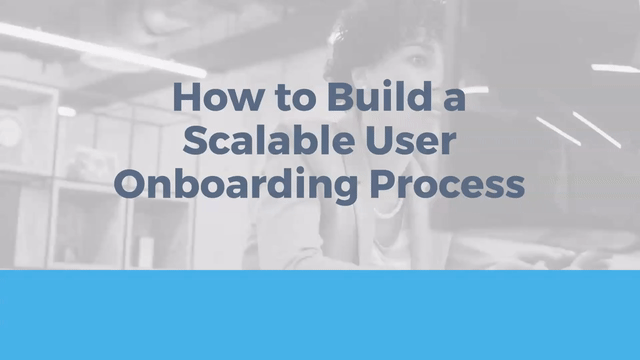Your product onboarding process is the initial spark that increases engagement and fuels product growth. Unfortunately, as your product and company grow, it’s easy to lose touch with users, and losing touch can quickly snuff out product growth.
That’s why it’s critical to craft an onboarding program that scales and maintains forward momentum, even as processes expand. Are you wondering how to do that?
We’ve nailed down the keys to creating a successful user onboarding program that scales and grows alongside your users.
What is the goal of user onboarding?
When it comes to successful user onboarding, the name of the game is time to value (TTV). The faster you can get customers to realize the value of your product or new feature, the sooner your team’s ROI will materialize. That’s why one of the most common goals of user onboarding is to slim down your TTV.
Don’t know where to start?
To speed up your user onboarding process, dig into the numbers. By pairing onboarding strategies with key performance indicators (KPIs), you can measure the health of your user onboarding program and drive success.
Here are a few metrics to tag to your onboarding process as you work to accelerate TTV:
- Customer acquisition cost: If you launch a successful user onboarding experience, it should lower your customer acquisition cost (CAC). That’s because—in addition to boosting online and word-of-mouth referrals—a positive onboarding experience will encourage more repeat users, upsells, and loyal, long-term customers.
- Churn-to-growth rates: In the software-as-a-service (SaaS) world, growing is not enough. To increase profits, you also need to reduce churn and secure more long-term users. That’s why it’s important to monitor churn-to-growth rates as you work to perfect your user onboarding process.
- Net dollar retention: Gone are the days when you could pepper messages across the globe and rely on one-off sales to grab profit. Today, success in SaaS requires subscriptions, consistent users, and ongoing product enhancements. Net dollar retention (NDR) gives you a birds-eye view of your ROI as you improve your onboarding process and new product experiences.

How to Create Scalable User Onboarding
If you want to create a scalable user onboarding process, customer and user data will be your best friend. With KPIs powering your efforts, it will be easier to monitor progress and identify whether or not your plans are taking off. Here are a few tips for using data to create a scalable user onboarding program:
Identify Expectation Gaps
One of the easiest ways to predict and eliminate negative experiences that turn users off is by identifying expectation gaps. With data—such as surveys and Net Promoter Scores (NPSs)—you can determine what a user expects and compare that to perceived value. From there, you can use educational materials or make product enhancements to narrow that gap.
Build Feedback into the Onboarding Process
Done right, feedback can turn into a current that runs through your product-growth strategy and electrifies your onboarding process. By building customer feedback loops into your user onboarding process, you accomplish a few things simultaneously:
- You show users they’re being heard.
- You better understand how to improve the customer experience.
- You test and adjust to your onboarding process’ results.
Use Data to Improve Your Product
In-product data analysis can shed light on the biggest growth opportunities hidden within your user onboarding process. For instance, a deep dive into path analysis or customer surveys can reveal sticky features. By identifying these popular features, you’ll have what you need to carve clear workflows to those features or replicate those valuable spots in your product. In turn, directing users towards these valuable elements of your product early on will hook them and keep them engaged longer.
Educate Users
If your user onboarding experience is lacking, nine times out of 10 you can fill in the gaps with education. For instance, by sprinkling in-product guides or demo videos to explain how a feature works, you empower the user to make use of it. As users learn about features, they feel more willing to embrace new ideas and start trusting your brand to lead them.
Take Advantage of Integrations
Your user experience doesn’t stop with your product. That’s why integrations are critical to your in-product tool as you grow. By using an in-product tool that integrates with third-party platforms, you can keep your data connected when users offer up information on other platforms. For instance, if a user raises their hand in Slack during the onboarding process, integrations let you pull that info into your in-product tool. This means you don’t miss out on key information or interactions as your team expands.
Replicate Positive Experiences
As the company grows, it’s easy to become complacent. Unfortunately, if you aren’t actively tracking the customer experience and improving your product, users can feel like they’re drifting further and further away.
That’s why it’s a good idea to improve the customer experience early on in the onboarding process by promoting sticky features and enhancing underused features. This approach not only feeds customers the experiences they crave, but also makes them feel understood.
Learn More Insights From the Top B2B Product Teams
With these tips for building a scalable onboarding process, you should be on your way to increased product growth and happier users. And we have more secrets about using the data you have to improve your users’ product experience. Download our white paper and find out which metrics the biggest SaaS organizations use to measure their product strategy success.

